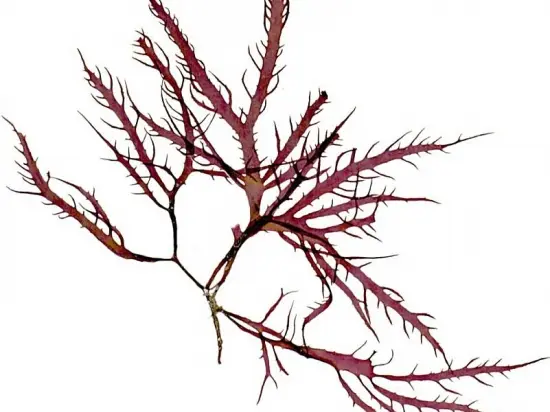
Calliblepharis jubata
weeks

Typical applications: Calliblepharis jubata
Typical applications
Culinary Uses: In some cultures, Calliblepharis jubata is harvested for culinary use, particularly in traditional dishes. It can be added to soups or salads, providing flavor and nutritional value.
Medicinal Properties: Like other red algae, Calliblepharis jubata may contain bioactive compounds with potential health benefits, although research is ongoing to fully understand its medicinal properties.
Aquaculture: This algae can be used in aquaculture systems, serving as a natural food source for herbivorous fish and contributing to sustainable farming practices.

ALGANEX certificate system
Product information: Calliblepharis jubata
Calliblepharis jubata is a species of red algae belonging to the family Calliblepharaceae.
Key Characteristics
Appearance: Calliblepharis jubata typically has a tufted or bushy appearance, characterized by long, slender filaments that can form dense mats. The color can range from red to dark brown, often with a shiny surface due to the presence of polysaccharides.
Habitat: This algae is primarily found in shallow marine environments, including rocky shores and coral reefs. It tends to thrive in areas with strong water movement and good light exposure.
Distribution: Calliblepharis jubata is found in tropical and subtropical waters, particularly in regions such as the Caribbean and parts of the Pacific Ocean.
Ecological Importance
Habitat Provider: The dense growth of Calliblepharis jubata provides habitat and food for various marine organisms, including small fish and invertebrates, contributing to the overall biodiversity of the ecosystem.
Nutrient Cycling: As a primary producer, it plays a role in nutrient cycling, helping to stabilize the marine environment and supporting other organisms in the food web.
Reproduction and Growth
Reproductive Structures: Calliblepharis jubata reproduces sexually and asexually, with spores that can settle and grow into new filaments.
Growth Conditions: It thrives in nutrient-rich waters with adequate light, making it well-suited for shallow coastal environments.
Environmental Considerations
While Calliblepharis jubata plays a beneficial role in marine ecosystems, it can also be susceptible to environmental changes, such as pollution and habitat destruction, which can impact its populations.
What are the key characteristics and appearance of Calliblepharis jubata?
Calliblepharis jubata typically has a tufted or bushy appearance with long, slender filaments that can form dense mats. The color ranges from red to dark brown, and it has a shiny surface due to the presence of polysaccharides.
In what types of habitats can Calliblepharis jubata typically be found?
Calliblepharis jubata is primarily found in shallow marine environments, including rocky shores and coral reefs. It thrives in areas with strong water movement and good light exposure.
What nutritional components does Calliblepharis jubata contain that make it beneficial for human consumption?
Calliblepharis jubata is rich in vitamins, minerals, and dietary fiber. It may contain essential nutrients such as iodine, calcium, and antioxidants, making it a nutritious addition to the diet.
How is Calliblepharis jubata used in traditional cuisines?
Calliblepharis jubata is harvested for culinary use in some cultures, particularly in traditional dishes where it can be added to soups or salads, providing flavor and nutritional value.
What are the potential health benefits associated with consuming Calliblepharis jubata?
Potential health benefits include antioxidant properties, support for digestive health, and provision of essential nutrients that may enhance overall well-being.
How does Calliblepharis jubata contribute to marine ecosystems?
Calliblepharis jubata provides habitat and food for various marine organisms, including small fish and invertebrates, thereby enhancing biodiversity and contributing to nutrient cycling.
Can Calliblepharis jubata be used in skincare products, and if so, how?
Yes, extracts from Calliblepharis jubata can be used in skincare products for their hydrating and soothing properties, potentially improving skin texture and providing antioxidant benefits.
What bioactive compounds are found in Calliblepharis jubata, and what are their effects?
Calliblepharis jubata contains bioactive compounds such as polysaccharides and phenolic compounds, which may have anti-inflammatory, antimicrobial, and health-promoting effects.
Is Calliblepharis jubata used in aquaculture, and how does it benefit fish farming?
Yes, Calliblepharis jubata can serve as a natural food source for herbivorous fish in aquaculture, promoting their growth and contributing to sustainable farming practices.
What environmental conditions favor the growth of Calliblepharis jubata, and how can it be sustainably harvested?
Calliblepharis jubata thrives in nutrient-rich waters, particularly in shallow coastal areas. Sustainable harvesting involves cutting fronds instead of uprooting the plant to allow for regeneration.
Sources
- Allmendinger A, Spavieri J, Kaiser M, Casey R, Hingley-Wilson S, Lalvani A, Guiry M, Blunden G, Tasdemir D. Antiprotozoal, antimycobacterial and cytotoxic potential of twenty-three British and Irish red algae. Phytother Res. 2010 Jul;24(7):1099-103. doi: 10.1002/ptr.3094. PMID: 20077438. (https://pubmed.ncbi.nlm.nih.gov/20077438/)
- Rocha CP, Pacheco D, Cotas J, Marques JC, Pereira L, Gonçalves AMM. Seaweeds as Valuable Sources of Essential Fatty Acids for Human Nutrition. Int J Environ Res Public Health. 2021 May 7;18(9):4968. doi: 10.3390/ijerph18094968. PMID: 34067088; PMCID: PMC8124752. (https://pubmed.ncbi.nlm.nih.gov/34067088/)
Reply within twelve hours